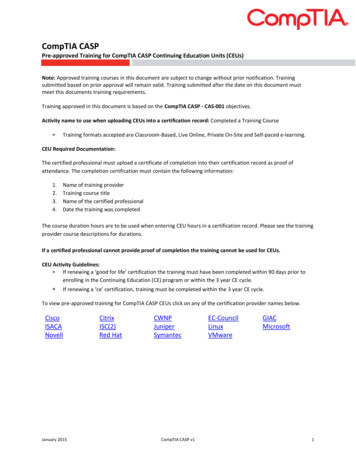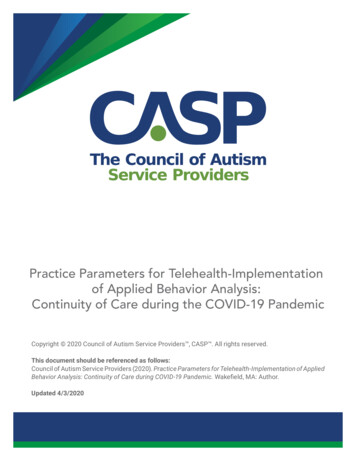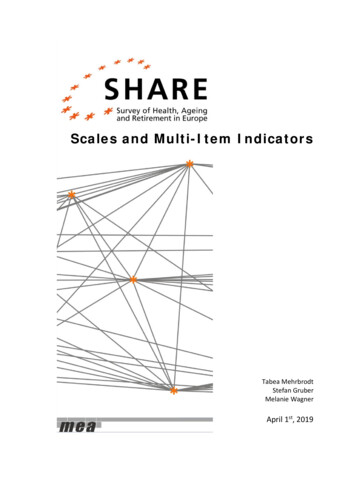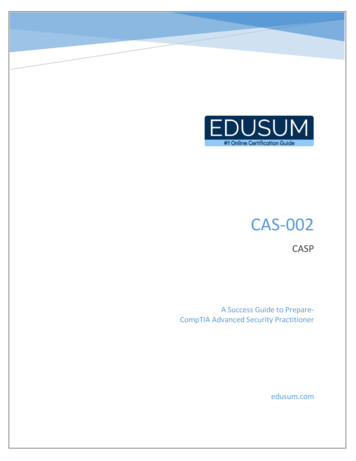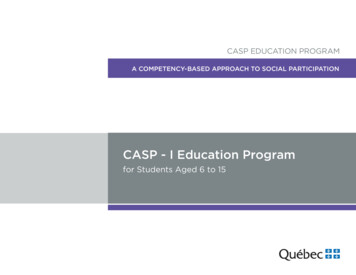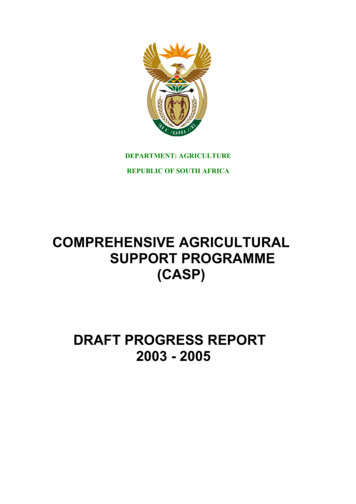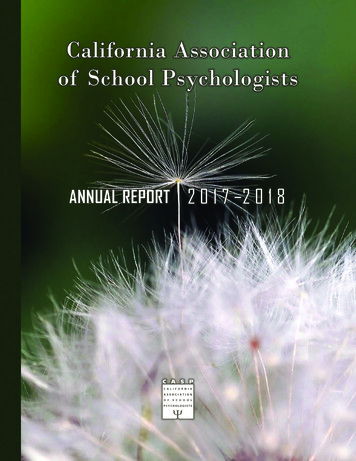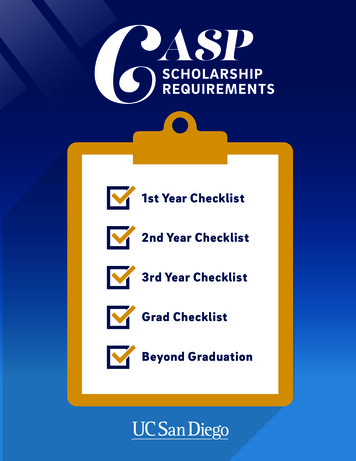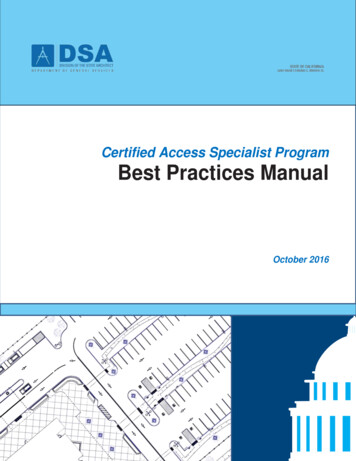
Transcription
Certified Access Specialist ProgramBest Practices ManualOctober 2016
CERTIFIED ACCESS SPECIALIST PROGRAMBEST PRACTICES MANUALINTRODUCTIONThis manual addresses best practices for the Certified Access Specialist (CASp).Requirements designated as stated in statute are required, and the CASp is advised toread the referenced statute in its entirety, beyond the minimum statutory informationprovided herein, to ensure that the CASp meets the full requirements of statute. Informationprovided by the Division of the State Architect (DSA) as best practices contained hereinconstitutes a guide and is not regulatory, but is provided so that an element of consistencyin the interpretation of statutes can be offered to all CASps. The information is derived fromfederal guidance and from the recommendation of those with extensive experience inproviding accessibility-related services prior to the existence of the CASp Program. TheCASp may elect to incorporate some or all of the best practices into his/her respectivepractice.CONTACTING DSAWebsite: www.dgs.ca.gov/caspMailing Address:Division of the State ArchitectCASp Program1102 Q Street, Suite 5100Sacramento, CA 95811Email:CASprogram@dgs.ca.govQuestions about examination and certification can be directed to the CASp ProgramCertification Line at (916) 323-2737.Questions regarding the technical requirements of providing the services of a CASp shouldbe directed to (916) 322-2490.Questions regarding the accessibility provisions of Chapter 11B of the California BuildingCode should be directed to the DSA Technical Assistance Helpline at (916) 445-5827.Revised 10/2016Page i
Revised 10/2016Page ii
TABLE OF CONTENTSI. INSPECTION REPORTS . 1Inspection Reports Provided By the Independent CASp . 1Impartial Determinations . 2Applicable Definitions . 2CRASCA Legal Benefits . 3Reduced Liability for Minimum Statutory Damages . 3Protection From Liability for Minimum Statutory Damages . 4CASp Required Actions for Owners Who Opt for 120-Day Compliance . 5II. BEST PRACTICES . 6Pre-Inspection Inquiry . 6Additional Recommendations for the Inspection Report . 6Issuance of the Schedule of Improvements . 7Owners Who Opt for 120-Day Compliance Schedule. 7Display of Disability Access Inspection Certificates . 8Completion of Services . 8Expedited Review of Construction Documents Submitted for Permit . 9Work Assisted by Others Who Are Not Certified . 9III. CASp GUIDANCE . 10Use of CBC Terminology . 10USDOJ Technical Guidance on Readily Achievable Barrier Removal. 11Availability of Tax Incentives for Access Improvements . 12Availability of Loans Under the CALCAP ADA Financing Program . 13IV. CASp RESOURCES . 14History of Disability Rights In California . 14California Laws Relating to Disability Access . 14California Legislation . 15Revised 10/2016Page iii
Revised 10/2016Page iv
I. INSPECTION REPORTSINSPECTION REPORTS PROVIDED BY THE INDEPENDENT CASpThe minimum requirements of an inspection report are not specified by the CASp Program.There is implied, however, a minimum of two types of inspection reports a CASp can issue:an inspection report that is issued according to Civil Code sections 55.51-55.545(Construction-Related Accessibility Standards Compliance Act [CRASCA]) and aninspection report that is not issued according to CRASCA.Inspection Reports Issued According to CRASCAAn inspection to the applicable standards, with an inspection report that is issuedaccording to CRASCA, offers legal benefits to a business/facility owner that hires aCASp and commits to achieving compliance according to an established schedule.CRASCA states specific content for the inspection report provided by a CASp if thereport is a deliverable that provides "qualified defendant" status to a business/facilityowner who hires a CASp for that purpose. Such requirements are stated in statuteand in the CASp Examination, Certification, and Practice Standards Handbookunder section VIII Professional Standards: CASp Inspection Reports IssuedAccording to Civil Code section 55.53. A CASp may review section II Best Practices,included herein, for information that may be relevant to include in the report, beyondthe minimum requirements as specified in CRASCA.As stipulated in CRASCA, an inspection report issued according to Civil Codesection 55.53 provides "qualified defendant" status only if the client has not yet beenserved a summons and complaint of a construction-related accessibility claim for thesubject property requiring inspection. In addition, because the legal benefit offeredby an inspection report issued according to CRASCA is established in California law,the "qualified defendant" status is recognized only in the California Court system andnot in the United States Federal Court system.Inspection Reports Not Issued According to CRASCAIf the CASp is providing services in which an inspection report is issued, but theowner does not desire to be offered the legal benefits under CRASCA, reportingrequirements are not specified and the applicable content is determined by theCASp. A CASp may review section II Best Practices, included herein, for informationthat may be relevant to include in the report.Revised 10/2016Page 1
IMPARTIAL DETERMINATIONSWhen providing an inspection of a facility and issuing an inspection report according to therequirements of CRASCA, it is recommended that a CASp be impartial. Facility inspectionsand inspection reports issued according to CRASCA are to the applicable standards. It isrecommended that the CASp ask the owner about the construction history of the facility sothat the applicable standards can be determined, in order to establish the basis of theinspection. If the applicable standards are unable to be determined, it is recommended thatthe CASp advise the owner that using current standards instead of the applicablestandards may lead to additional improvements as a result of the more restrictivecompliance requirements of current standards.APPLICABLE DEFINITIONSThe following definitions are applicable to the requirements, as stipulated in CRASCA.Inspected by a CASp means the site was inspected by a CASp and is pending adetermination by the CASp that the site meets applicable construction-relatedaccessibility standards. A site that received a determination of "CASp DeterminationPending" before October 2012 means that the site was "inspected by a CASp."Meets applicable standards means the site was inspected by a CASp anddetermined to meet all applicable construction-related accessibility standards. A sitethat received a determination of "CASp Inspected" before October 2012 means thatthe site "meets applicable standards."Construction-related accessibility standard is a provision, standard, or regulationunder state or federal law requiring compliance with standards for making newconstruction and existing facilities accessible to persons with disabilities, includingbut not limited to any provision standard or regulation set forth in the California CivilCode section sections 51–55, Health and Safety Code section 19955.5, theCalifornia Building Standards Code (Title 24 of the California Code of Regulations),and the federal Americans with Disabilities Act (ADA) of 1990 (Appendix A to Part 36of Title 28 of the Code of Federal Regulations).Readily achievable barrier removal is defined by the ADA (42 USCode §12181(9);28 Code of Federal Regulations §36.104.2) as "easily accomplishable and able to becarried out without much difficulty or expense." For further information, please seepage 11.Revised 10/2016Page 2
Qualified defendant is a defendant in an action that includes a construction-relatedaccessibility claim that is asserted against a place of public accommodation that metthe requirements of “meets applicable standards” or “inspected by a CASp” prior tothe date the defendant was served with the summons and complaint in that action.To be a “qualified defendant,” the defendant is not required to have been the partywho hired any CASp, so long as the basis of the alleged liability of the defendant is aconstruction-related accessibility claim. To determine whether a defendant is a“qualified defendant,” the court does not need to make a finding that the place ofpublic accommodation complies with all applicable construction-related accessibilitystandards as a matter of law. The court need only determine that the place of publicaccommodation has a status of “meets applicable standards” or “inspected by aCASp,” which all facilities inspected according to CRASCA receive. Notwithstandingany other law, upon being served with a summons and complaint asserting aconstruction-related accessibility claim, a “qualified defendant” may request a courtstay and early evaluation conference in the proceedings of that claim prior to, orsimultaneous with, that defendant's responsive pleading or other initial appearancein the action that includes the claim.CRASCA LEGAL BENEFITSCivil Code section 55.54 offers a 90-day court stay and early evaluation conference to abusiness/facility owner who is a “qualified defendant.”REDUCED LIABILITY FOR MINIMUM STATUTORY DAMAGESCivil Code section 55.56 provides for a reduction in the amount of liability for statutorydamages by the owner who holds an inspection report issued according to CRASCA.Statutory damages are reduced from 4,000 minimum per occasion to a minimum of 1,000 per occasion if the structure or area of the alleged violation was the subject of aninspection report indicating “CASp determination pending” or “Inspected by a CASp,” thebusiness/facility owner agrees to correct the violation within 60 days of the claim, and thebusiness/facility owner has either implemented reasonable measures to correct the allegedviolation before the particular occasion on which the plaintiff was allegedly denied full andequal access, or the business/facility owner was in the process of correcting the allegedviolation within a reasonable time and manner before the particular occasion on which theplaintiff was allegedly denied full and equal access.Revised 10/2016Page 3
PROTECTION FROM LIABILITY FOR MINIMUM STATUTORY DAMAGESCivil Code section 55.56(g)(3)(A) states: A defendant shall not be liable for minimumstatutory damages in a construction-related accessibility claim, with respect to a violationnoted in a report by a CASp, for a period of 120 days following the date of the inspection ifthe defendant demonstrates compliance with each of the following:1. The defendant is a business that, as of the date of inspection, has employed 50 orfewer employees on average over the past three years, or for the years it has beenin existence if less than three years.2. The structure or area of the alleged violation was the subject of an inspection reportindicating “Inspected by a CASp.”3. The inspection predates the filing of the claim by, or receipt of a demand letter from,the plaintiff regarding the alleged violation of a construction-related accessibilitystandard, and the defendant was not on notice of the alleged violation prior to theCASp inspection.4. The defendant has corrected, within 120 days of the date of the inspection, allconstruction-related violations in the structure or area inspected by the CASp thatare noted in the CASp report that are the basis of the claim.A defendant may claim the protection from liability for minimum statutory damages onlyonce for each structure or area inspected by a CASp, unless the inspected structure orarea has undergone modifications or alterations that affect the compliance withconstruction-related accessibility standards of those structures or areas after the date of thelast inspection, and the defendant obtains an additional CASp inspection within 30 days offinal approval by the building department or certificate of occupancy, as appropriate,regarding the modification or alterations.If the defendant has failed to correct, within 120 days of the date of the inspection, allconstruction-related violations in the structure or area inspected by the CASp that are notedin the CASp report, the defendant shall not receive any protection from liability for minimumstatutory damages unless a building permit is required for the repairs which cannotreasonably be completed by the defendant within 120 days and the defendant is in theprocess of correcting the violations noted in the CASp report, as evidenced by having, atleast, an active building permit necessary for the repairs to correct the violation that wasnoted, but not corrected, in the CASp report, and all of the repairs are completed within 180days of the date of the inspection.Revised 10/2016Page 4
CASP REQUIRED ACTIONS FOR OWNERS WHO OPT FOR 120-DAY COMPLIANCECivil Code section 55.53(a)(3-5) states:The CASp shall provide, within 30 days of the date of the inspection of a business that, asof the date of inspection, has employed 50 or fewer employees on average over the pastthree years, or for the years it has been in existence if less than three years, a copy of theinspection report to the business, if the business owner has opted for the 120-daycompliance schedule.The CASp shall file with DSA a Notice of Access Inspection and 120-Day Grace Period, within10 days of inspecting a business, for the purpose of listing the notice on DSA’s website.DSA has made the notice available on the CASp Program website. The notice is fillableonline and may be submitted directly to the CASp Program at CASprogram@dgs.ca.gov.The CASp shall post the same notice at the inspected site, in a conspicuous location withinfive feet of all public entrances to the building, on the date of the inspection and instruct thebusiness to keep it in place until the earlier of either of the following:A. One hundred twenty days after the date of the inspection.orB. The date when all of the construction-related violations in the structure or areainspected by the CASp are corrected.Revised 10/2016Page 5
II. BEST PRACTICESDSA provides the following as "best practices" for the inspection report.PRE-INSPECTION INQUIRYThe basis of the inspection may be determined from the following information, if available.This list is not inclusive of items to be considered.Information to request from the client: Contact information of client and relationship to owner.Type of property owner and type of client (whether public or private).Name and address of property.Age of the facility (year built).Description of the facility, including the nature of businesses in the facility.History of improvements.A description of the areas of the facility requested to be surveyed.Identification of public accommodation areas within area surveyed.ADDITIONAL RECOMMENDATIONS FOR THE INSPECTION REPORTThe following information is recommended for inclusion in the inspection report with theintent that it provides clarity for the owner and specifies the information the CASp used todetermine compliance with construction-related accessibility standards. The CASp shoulduse appropriate judgment with regard to inclusion of this additional information. Dependingon the specifics of the facility evaluated, this information is not inclusive of all additionalinformation that may be included for the inspection report.The minimum requirements for an inspection report issued according to CRASCA arestipulated in Civil Code section 55.53 and in the CASp Examination, Certification, andPractice Standards Handbook under section VIII Professional Standards. In addition,Senate Bill 269 (SB 269 [Chapter 13, Statutes of 2016]) amended CRASCA, and since May10, 2016, requires the date of inspection to be included in all reports that receive adetermination of "inspected by a CASp." Beyond the minimum requirements, the followingis recommended information to include in an inspection report, if applicable and available:Revised 10/2016Page 6
Date of evaluation.Date of inspection report.Client contact information and relationship to owner.An indication that the report is issued according to the requirements of CRASCA(if applicable).Type of property owner and type of client (whether public or private).Name and address of property.Age of property (year built).Description of the facility, including the nature of businesses in the facility.History of improvements.A list of the standards to which the facility was inspected and why they areapplicable, or an indication that the inspection was to current standards and thereason for using current standards as the basis of inspection.An explanation of a determination of readily achievable barrier removal and howsuch a determination is made.A photo essay of noncompliant conditions.A record of noncompliant measurements taken on-site.CASp signature and CASp number.ISSUANCE OF THE SCHEDULE OF IMPROVEMENTSCivil Code section 55.53 requires a schedule of completion for each of the corrections withreasonable timeframes. While "reasonable" is not defined, "reasonableness" may take intoconsideration the costs incurred by the client to complete the work, which may include theinvolvement of design professionals, construction professionals, the permitting andinspection process, the ability to secure a loan from a financial institution, if the owner sodesires, or the ability to schedule the work in consideration of the owner's budgetaryconstraints. Under CRASCA, the owner's commitment to achieving compliance isdemonstrated by the owner's adherence to the correction schedule; therefore, a CASpshould work with the owner to establish a reasonable schedule, and the owner mustunderstand that he/she is still exposed to having a claim filed while violations are beingcorrected or on violations that remain uncorrected.OWNERS WHO OPT FOR 120-DAY COMPLIANCE SCHEDULECRASCA inspection reports that have a determination of "inspected by a CASp" arerequired to have included with the report a reasonable schedule for improvements. For abusiness/facility owner who has opted for a 120-day compliance schedule, theRevised 10/2016Page 7
improvement schedule is implied by statute to be 120 days. To meet the requirements instatute that a schedule be included with the report, the CASp Program recommends thatthe CASp state in the report that the business/facility owner has opted for a complianceschedule of 120 days to take advantage of the grace period for liability from statutorydamages, as provided in Civil Code section 55.56(g)(3)(A).In addition, it is wise for the CASp to inform the owner that, if correction of the violations inthe report are not completed within 120 days of the inspection, and if an active permit is notin place to that extends the grace period to 180 days from the inspection date, the ownermay be eligible for a reduction in minimum statutory damages if the owner is able todemonstrate reasonable measures to correct violations are in place or violations are in theprocess of being corrected.DISPLAY OF DISABILITY ACCESS INSPECTION CERTIFICATESA disability access inspection certificate (DAIC) is issued to a business/facility owner with areport issued according to CRASCA. It is not required that the DAIC be posted on thepremises; it is at the discretion of the business or facility owner. The CASp mayrecommend that the business have the DAIC available should an individual request proof ofinspection and, according to CRASCA, advise that inspection reports remain confidential. Itis recommended that a business and/or facility owner should not provide the inspectionreport as evidence of proof of inspection to anyone unless advised by legal counsel.A business or facility owner that elects to post the DAIC at the premises may be advised bythe CASp to post a color copy and retain the original in safekeeping. A numbered DAIC islinked to an inspection report issued according to CRASCA; therefore, if issuance of areplacement is necessary, its issuance may necessitate documentation on the DAIC recordthat it is issued as a replacement of an original certificate.COMPLETION OF SERVICESUpon completion of the inspection and along with the inspection report issued according toCRASCA, Civil Code section 55.53 requires the CASp to provide the business/facilityowner with a DAIC purchased from DSA, and a Notice to Property Owner/Tenant regardingsafekeeping of Inspection Reports. In addition, according to Civil Code section 55.53(e),the CASp shall record the number of the issued DAIC, the name and address of therecipient, and the determination of the CASp Inspection Report issued (either “meetsapplicable standards” or “inspected by a CASp”) in a record book.Revised 10/2016Page 8
The CASp is not required by CRASCA to provide a final inspection of the site aftercompletion of improvements in order for the business and/or facility owner to receive ormaintain "qualified defendant" status; however, if one is requested, it is recommended thatit be specified in the scope of services in the Agreement, or as an amendment to theAgreement.EXPEDITED REVIEW OF CONSTRUCTION DOCUMENTS SUBMITTED FOR PERMITAccording to Government Code section 65946, a jurisdictional agency is required toprovide expedited review of the project application if the applicant demonstrates thefollowing: Provides a disability access inspection certificate.Declares the project is for correction of violations addressed in a CRASCA report.A CASp has reviewed the project plans.When providing inspections under CRASCA, the CASp is advised to inform the owner ofthis benefit, and that the CASp can provide the service of plan review and provide theowner with proof of plan review.WORK ASSISTED BY OTHERS WHO ARE NOT CERTIFIEDIn the course of an inspection of a facility, a CASp may utilize the assistance of others whoare not certified. An inspection report issued according to the requirements of Civil Codesection 55.53, however, requires the CASp to sign and date a statement with adetermination based on the result of the inspection. DSA reminds the CASp that, accordingto CASp Program Regulations, the signature of the CASp on an inspection report orinspection record signifies that the CASp has been on the subject site as part of the scopeof services and can confirm the information stipulated in the inspection report or inspectionrecord.Revised 10/2016Page 9
III. CASp GUIDANCEUSE OF CBC TERMINOLOGYThe CASp is reminded that the following terminology is defined in California Building Code(CBC), Part 2, Chapter 2:Technically Infeasible: An alteration of a building or a facility that has littlelikelihood of being accomplished because the existing structural conditions requirethe removal or alteration of a load-bearing member that is an essential part of thestructural frame, or because other existing physical or site constraints prohibitmodification or addition of elements, spaces or features which are in full and strictcompliance with the minimum requirements for new construction and which arenecessary to provide accessibility.Where the enforcing authority determines compliance with applicable requirementsis technically infeasible, the alteration shall provide equivalent facilitation or complywith the requirements to the maximum extent feasible. The details of the finding thatfull compliance with the requirements is technically infeasible shall be recorded andentered into the files of the enforcing agency.Unreasonable Hardship: When the enforcing agency finds that compliance withthe building standard would make the specific work of the project affected by thebuilding standard infeasible, based on an overall evaluation of the following factors:1. The cost of providing access.2. The cost of all construction contemplated.3. The impact of proposed improvements on financial feasibility of the project.4. The nature of the accessibility which would be gained or lost.5. The nature of the use of the facility under construction and its availability topersons with disabilities.The details of any finding of unreasonable hardship shall be recorded and entered inthe files of the enforcing agency.While "technically infeasible" is also defined similarly within the context of the 2010 ADAStandards for Accessible Design (ADAS), it is recommended that the CASp advise theowner to seek confirmation of technical infeasibility by the jurisdictional agency in order toRevised 10/2016Page 10
support such findings, which would lead to the determination that a correction of a violationis "not readily achievable."USDOJ TECHNICAL GUIDANCE ON READILY ACHIEVABLE BARRIER REMOVALThe ADA requires Title III entities (public accommodations and commercial facilities) builtprior to January 26, 1992, to remove barriers if "readily achievable to do so." Readilyachievable barrier removal is defined by the ADA as "easily accomplishable and able to becarried out without much difficulty or expense." Readily achievable barrier removal is notapplicable to Title II facilities (state and local governments).As provided by the ADA, determinations as to which barriers can be removed without muchdifficulty or expense must be made on a case-by-case basis. A determination of readilyachievable barrier removal is made with a comprehensive understanding of the factors tobe considered. In determining whether an action is readily achievable, factors to beconsidered, per 42 U.S.Code section 12181(9)(A) - (D), and 28 Code of FederalRegulations section 36.104, include the following:(1) The nature and cost of the action needed under this part;(2) The overall financial resources of the site or sites involved in the action; the numberof persons employed at the site; the effect on expenses and resources; legitimatesafety requirements that are necessary for safe operation, including crime preventionmeasures; or the impact otherwise of the action upon the operation of the site;(3) The geographic separateness, and the administrative or fiscal relationship of the siteor sites in question to any parent corporation or entity;(4) If applicable, the overall financial resources of any parent corporation or entity; theoverall size of the parent corporation or entity with respect to the number of itsemployees; the number, type, and location of its facilities; and(5) If applicable, the type of operation or operations of any parent corporation or entity,including the composition, structure, and functions of the workforce of the parentcorporation or entity.The ADA contains a list of 21 examples of modifications that may be readily achievable:1. Installing ramps;2. Making curb cuts in sidewalks and entrances;3. Repositioning shelves;Revised 10/2016Page 11
4. Rearranging tables, chairs, vending machines, display racks, and other furniture;5. Repositioning telephones;6. Adding raised markings on elevator control buttons;7. Installing flashing alarm lights;8. Widening doors;9. Installing offset hinges to widen doorways;10. Eliminating a turnstile or providing an alternative accessible path;11. Installing accessible door hardware;12. Installing grab bars in toilet stalls;13. Rearranging toilet partitions to increase maneuvering space;14. Insulating lavatory pipes under sinks to prevent burns;15. Installing a raised toilet seat;16. Installing a full-length bathroom mirror;17. Repositioning the paper towel dispenser in a bathroom;18. Creating designated accessible parking spaces;19. Installing an accessible paper cup dispenser at an existing inaccessible waterfountain;20. Removing high pile, low density carpeting; or21. Installing vehicle hand controls.Additionally, readily achievable barrier removal applies to facilities in compliance with the1991 Standards with regard to those elements in the 2010 ADA Standards that were notpreviously addressed in the 1991 ADA Accessibility Guidelines (1991 ADAAG).Civil Code section 55.53 does not require the CASp to make a determination of readilyachievable barrier removal; the statute only requires the CASp to clearly indicate whetherthe CASp has made such a determination in the inspection report. If the CASp does nothave a comprehensive understanding of the factors to be considered as they relate to theclient, then the CASp ma
CASp and commits to achieving compliance according to an established schedule. CRASCA states specific content for the inspection report provided by a CASp if the report is a deliverable that pro
